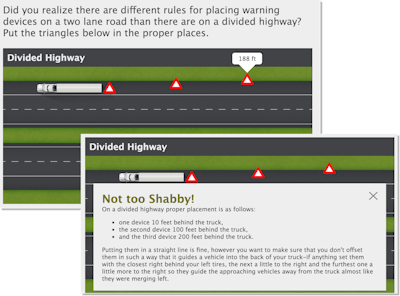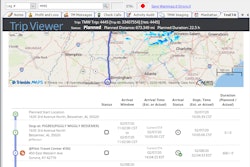 The DRIVE FIRST online learning management system from Luma gives drivers searchable training content to quickly find answers.
The DRIVE FIRST online learning management system from Luma gives drivers searchable training content to quickly find answers.Transportation companies have traditionally used videos for driver training. While video lightens the workload for fleet administrators, the learning medium often makes drivers less efficient, according to new research by instructional design and learning company Luma “Brighter Learning.”
“Efficiency” is a term learning theorists use to describe the performance and mental effort of the learner. By this definition, video can be the least efficient learning medium for drivers in many situations.
“Video is not inherently bad or inefficient, but you have to know the learner and under what situation it is going to be effective,” says Gina Anderson, Ed.D., chief executive officer of Luma and expert in adult learning.
Luma presents new research in a whitepaper, “Are videos the primary medium you use?” that explores the best methods to facilitate learning and development for professional truck drivers.
Finding the best fit
Video can be a highly efficient medium for psychomotor learning, which is the relationship between cognitive functions and physical movement, says Dr. Anderson. Examples of where video can be used effectively include training drivers to operate specific types of equipment and how to avoid common work injuries.
 Petroleum transporter R.B. Stewart has saved more than $10,000 in two months of using interactive driver training from Luma Brighter Learning.
Petroleum transporter R.B. Stewart has saved more than $10,000 in two months of using interactive driver training from Luma Brighter Learning.Where the medium often falls short is cognitive learning. Video is inherently linear, the whitepaper notes, and drivers can only get through the material by passively listening and watching. Drivers can quickly lose interest as well. Studies show the average attention span for adult learners with video is about 8.5 seconds.
Learners may also have difficulty remembering information presented in a video and cannot easily go back and search for it.
For certain topics, video has a unique capacity to grab drivers’ attention. Fleets using Luma’s DRIVE FIRST learning management system (LMS) often incorporate dash camera footage of accidents, road rage and other incidents into learning modules called Luma eNuggets, Dr. Anderson notes.
Dash cam footage gives drivers an authentic learning experience and builds relevance for training topics, she explains.
Even if videos are highly engaging, Anderson recommends that motor carriers keep videos short and simple. The whitepaper cites research that the average adult can only hold 7 ± 2 pieces of information in their working memory.
“Even if you are the smartest person in the room, due to cognitive limitations the brain is unable to process more than several pieces of information at a time,” she says.
Customized training
The whitepaper cites many examples of fleets using DRIVE FIRST and its collection of more than 350 Luma eNuggets to give drivers various media options to match individual learning preferences.
Some drivers like to read, others prefer to listen, and some learn best when using their hands to interact with the training content. Other drivers prefer to use an embedded reader in Luma eNuggets that allows the content to be read to the learner in their language of choice.
On average, drivers rate the eNugget training content 4.47 on a scale of 5 using an unsolicited rating system. They also return to the content frequently. On average, nearly 76% go back at least once and 29.7% return 10 times or more.
 In this example of Luma’s interactive driver training modules, drivers drag and drop the warning markers to the proper placement behind the truck.
In this example of Luma’s interactive driver training modules, drivers drag and drop the warning markers to the proper placement behind the truck.The DRIVE FIRST platform is designed to incorporate unlimited mediums in the eNugget modules, and give fleet administrators the flexibility to include their own text, infographics, animation, and video within a pre-made template.
According to the whitepaper, 96 percent of Luma’s clients customize the eNuggets to make them their own instead of using the content out of the box.
Giving drivers control over their own learning is also important, notes Dr. Anderson. When using the eNugget learning modules, drivers can view assessment questions at any time, but fleets can also change settings to require drivers complete some or all of the steps first.
If a driver is able to answer all the questions upfront, “why should they be forced to sit through training?” Dr. Anderson asks.
Drivers can identify topics from the assessment they already know and tailor the experience and media preferences to maximize their learning efficiency, Dr. Anderson explains.
CCJ has shared results from a number of motor carriers that use the platform, which include Paper Transport, Fraley & Schilling, Premium Transportation Logistics, Certified Freight Logistics, and R.B. Stewart.
Click here to download a free copy of the whitepaper or visit www.learnwithluma.com














